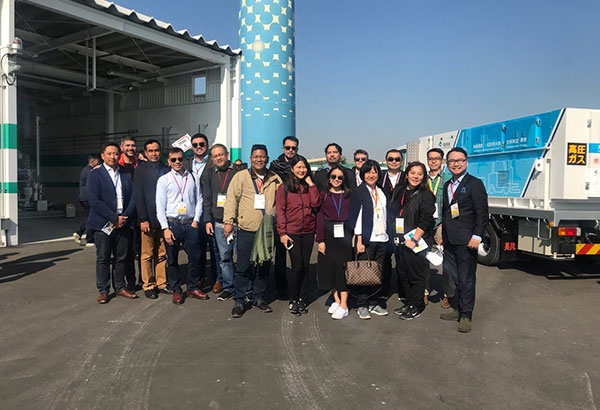Wind & water: How Toyota fuels a clean future

Toyota Motor Philippines’ Carlo Ablaza, Atty Rommel Santiago and Jade Sison join the author and members of the motoring media in a visit to the Hama Wing Facility in Yokohama, Japan.
Innovative and bold. In a world where conventional practices have led to our current environmental problems, solutions require the ability to innovate new technologies and the courage to apply them. Among automobile companies, Toyota excels at being innovative and bold to develop environment-friendly technologies.
Toyota has been a recognized leader in the hybrid market, after its introduction of the Prius in 1997. Toyota’s Mirai was one of the first fuel-cell hydrogen vehicles available commercially. When I first drove a Mirai in 2015, I was impressed with its ability to accelerate and drive as if it were a gas-powered vehicle. I consider the Mirai as a hybrid vehicle par excellence—it uses hydrogen as energy to generate electricity and power the vehicle. Mirai’s Toyota Fuel Cell System (TFCS) has high energy efficiency compared with conventional internal combustion engines.
The technologies behind the Prius and Mirai are now part of a bigger project that goes beyond cars. The “Low-Carbon Hydrogen Supply Chain Demostration Project” (Hydrogen Supply Project) integrates power generation, fuel production and vehicle operation with zero carbon footprint. The project demonstrates a supply chain of storage and delivery of low-carbon hydrogen produced at the Yokohama Wind Power Plant (aka “Hama Wing”) to power fuel cell forklifts. The main goal is to achieve a simple, integrated system that uses hydrogen to contribute to future regional development and global warming countermeasures.
With an implementation period from 2015 to 2018, the Hydrogen Supply Project is a collaborative effort involving the government (including the Ministry of Environment), academe and industry players. Toyota Motor Corporation is a member of the project’s “Secretariat” and its unit for “Feasibility Study and Future Development Assessment.”
I visited the Hama Wing in Yokohama last week to personally witness how this Project works. The Hydrogen Supply Project is a beautiful, intricate system consisting of wind-power, batteries, and vehicle technologies that I would attempt to describe in this article.
First, electricity is generated using wind from the Hama Wing Wind Power Plant. Hama Wing uses a wind-turbine manufactured by Vestas (Denmark) towering at 78m with a rated output of 1,980kW (annual output is around 2.1 million kWh). An educational display board is installed in Rinko Park, which allows people to monitor the status of power generated at Hama Wing at any time.
Since wind is an intermittent energy source, variations in electric power are stabilized through the use of an energy storage system. Energy produced from Hama Wing is stored in a “Storage Battery System” that operates on 180 second-hand fuel cell packs taken from 180 Toyota Prius vehicles. This is another environment-friendly approach as the Project’s Storage Battery System re-uses end-of-life Prius batteries.
Electricity from Hama Wing is used to manufacture Hydrogen. Through the Battery Storage Facility, hydrogen can be produced in stable supply even when the wind is weak and Hama Wing cannot generate electricity. The manufacturing process utilizes a “water electrolysis system” that breaks down water (H2O) into hydrogen and oxygen to produce an almost 100% pure hydrogen gas.
A common disadvantage of some biofuels is that the energy source to produce them comes from dirty, conventional fuels such as coal or gas. For the Hydrogen Supply Project, there is no carbon footprint because wind power is used to operate the water eletrolysis equipment.
The Project’s system is designed for flexible hydrogen production according to variable wind power generation. To ensure stable supplies, two days’ worth of hydrogen fuel is accumulated. The main storage tank has a capacity of 800 Nm3, enough for two-days’ worth of hydrogen for 12 fuel-cell forklifts.
The stored hydrogen is pressurized using a compressor for storage in Japan’s first compact hydrogen fueling truck. The truck has a hydrogen-loading capacity of 270 Nm3, enough to fuel six fuel-cell forklifts. The truck itself is an environment-friendly hybrid vehicle that can transport pressurized hydrogen to forklift operators in various sites and perform on-site fueling. Through the Project’s operations management system, the hydrogen fuel of each forklift is remotely monitored and calculated so that fuel requests of each forklift are fulfilled through optimal delivery.
The fuel cell forklifts use the same fuel cells as the Toyota Mirai, in addition to a fuel cell system designed to operate the forklifts at high electricity generating efficiency. Each fuel cell forklift can lift up to 2.5 tons, and can supply 1kW of electric power for 15 hours. It takes only three minutes to fuel a forklift with hydrogen. When fully fueled, a forklift can operate for approximately eight hours (the same duration when using a lead battery). Because fueling is done by a compact fueling truck, a charging area or a replacement battery storage area is not required.
The Project has a total of 12 fuel cell forklifts which are currently being used in four different facilities in Yokohama and Kawasaki cities: Yokohama Central Wholesale Market (vegetables and fruits section); Kirin Yokohama Brewery; Nakamura Logistics Inc. (Kawasaki FAZ Distribution Center); and Nichirei Logistics Group (Higashi-Ogishima Distribution Center). These different facilities test the performance of fuel cell trucks for short distance and frequent use, transport of heavy objects, use in refrigerated warehouse and logistics, and indoor fueling. The fuel cell forklifts have no carbon emissions.
The Hydrogen Supply Project is an excellent system that is environmentally clean from end-to-end. The possibilities are great, with fuel cell forklifts demonstrating the ability to translate this technology for use in heavy equipment and other types of industrial vehicles.
I lef the Hama Wing facility inspired and optimistic. With Toyota and other industry, government and academic collaborators pushing for environment-friendly innovations, global warming issues can be preventable rather than inevitable.
- Latest






























